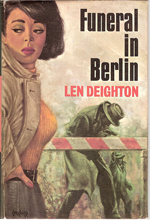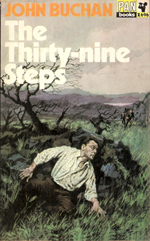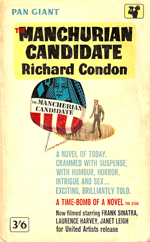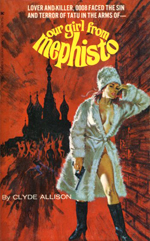 Author: Matt Hilton
Author: Matt Hilton
Publisher: Hodder and Stoughton
Release Year: 2010
Slash and Burn is the third novel in Matt Hilton’s Joe Hunter series following on from Dead Men’s Dust and Judgement and Wrath. Is Joe Hunter a spy? No, but that brings up an interesting question. What constitutes a spy story. If you’ll forgive me as I talk about spy films for a moment – here’s a little guide that I am sure I have posted before which relates to the different styles of spy films and the characters that populate them. The same is true for spy novels. I have edited it slightly to make it more relevant. In my view, the seven main spy story styles are:
the globe trotter

This is the most easily detected espionage story style. It features international globe trotting secret agents fighting crime and evil masterminds all around the globe. In some case the stories are barely more than glorified travelogues, but it makes for some fantastic backdrops to the action. This style of story proliferated in the sixties, when the jet-set age really took hold. Beautiful people in beautiful locations doing particularly nasty things seemed to be the maxim here. Perfect examples of these are the James Bond or Matt Helm stories, but even many of the lesser known tales of espionage liked to work in foreign locations. In fact, the locations used were often a selling points for these films or novels. If a spy story utilised an exotic location then it wasn’t unusual for that location to be mentioned in the title. The role call of destinations included, Our Man In Havana, Funeral In Berlin, That Man In Istanbul, Espionage In Tangiers, The Girl From Rio, Assassination In Rome, Our Man In Marrakech, Fury In The Orient, Hong Kong Hot Harbour, From Beijing With Love, Our Man In Jamaica and many, many others.
the innocent bystander

This is the classic wrong place at the wrong time scenario. The innocent bystander is the sneakiest, but probably the most common of the espionage story conventions. It is harder to detect because the hero is not a highly trained secret agent but anybody or everyman/woman. It is the innocent person who stumbles in on an incident or who gets caught up in the web of intrigue by accident. The classic example would have to be, The 39 Steps where Richard Hannay by shear happenstance gets caught up with foreign spies. Or The Russia House, where Boozey Barley Blair, a book publisher, is contacted by a Russian defector whilst at a book fair in Moscow. Also, the Innocent Bystander is the least male biased of the espionage conventions. Often it is woman who gets caught up in the conflict.
the sleeper

The sleeper is an enemy agent that is hiding in plain sight. They live amongst us, appearing to live a normal life. In reality they are lying dormant, just waiting for a trigger to send them off on their mission of destruction. The triggers that send the agents off can be phrases, such as poetry, or images, such as playing cards. The best example of films in this style is The Manchurian Candidate (1962), based on the best selling book by Richard Condon. It’s an absolutely amazing film starring Frank Sinatra and Lawrence Harvey. In the film, Harvey plays Raymond Shaw, the all American son of a prominent politician. During the Korean War, Shaw is brainwashed in Manchuria, and set to become a killer. His trigger is a playing card. Practically any story which features brainwashing is a sleeper story. In reality, by brainwashing somebody, you are trying to get the subject to complete a task that is against their will and not in character. This, I guess, makes them a sleeper agent. The final scenes of The IPCRESS File (the film ,that is) feature a mind altered Harry Palmer battling the instructions that he has been programmed with. Quite different, but with the same intent, the lovely ladies at Blofeld’s allergy clinic in On Her Majesty’s Secret Service have all been brainwashed and given instructions to unleash a deadly toxin at various locations around the world. The Sleeper is one of the most dangerous of enemy agents because they seem the most unlikely.
the soldier

Wartime spy dramas usually feature ‘The Soldier’. It’s always a thin line to tread, between some War stories and Spy stories, but generally the nature of the mission, helps separate them into their appropriate categories. For example there is no mistaking that films Saving Private Ryan, The Longest Day and Platoon – or the novel All Quiet on the Western Front are solely a war stories. Whereas stories such as Eye Of The Needle, Where Eagles Dare, The Eagle Has Landed, The Counterfeit Traitor, belong to the Spy genre.
the assassin
The Assassin is an interesting sub-genre of the usual secret agent movie, where the glossy veneer has been removed, and all that’s left is the ruthless bastard. Let’s face it though, most secret agents are paid killers, even the James Bond’s of the world are sugar coated assassins. The world of the assassin is an interesting one, and a topic that has been visited again and again. But there’s quite a bit of confusion over which films are in fact spy stories, and which are crime stories. I suggest it is the employer of the assassin that defines whether the character is a spy or crime story. But this category isn’t for the well manicured, well dressed gentleman spy. It is reserved for the men who specialise in ‘wet work’ – the HARD men of the genre.
the idiot

From the travesty that was Casino Royale in 1967 to more recent fare like the recent updates of I, Spy and Get Smart, there have been plenty of comedic attempts at capitalising on the success of spy films (spy novels too – look at the Clyde Allison 0008 stories or Alligator by I*n Fl*m*ng). Unfortunately few of them are very good. Most, to be honest are quite painful. Johnny English, Austin Powers and Le Magnifique are among the more successful attempts of the genre, but even they have their detractors. Many of the children’s spy films are clearly intended to be comedy films as well. Condorman and The Double ‘O’ Kid are prime examples. Both of them are bad films, but they were never intended to be taken seriously.
the retiree

There are two variations on the retiree spy film. The first and most obvious variation is where the old retired masterspy is called back into action for one final mission because he has a skill set that is essential to the successful completion of the mission. There are a whole swag of films like this, such as Firefox with Clint Eastwood, or even the Matt Helm films with Dean Martin. In the Helm films, Dino has retired and wants to be left alone with his camera and coterie of dolly birds, but somehow gets dragged back into the action time and time again. The mini-series, Icon based on Frederick Forsyth’s book, with Patrick Swayze also trots out the formula once again. Swayze’s character is called out of retirement because of his knowledge of antiquated biological agents.
The second variation, which could almost be called the ‘messed with the wrong guy’ spy film, usually features a band of villains picking on a person or group of civilians (often a family). It just so happens that these people have been befriended by or related to a retired bad-ass spy. To the villains, the spy just seems like an old codger (or a nobody), but we know, despite the wrinkles, this guy is a lethal weapon. If the plot device sounds familiar, it is. The 1987 film, Malone, starring Burt Reynolds is essentially an updated version of the classic western, Shane. Television shows in particular have latched onto this style of story, with Man In A Suitcase, The Equalizer, and even Burn Notice featuring agents who have been ‘retired’ from active duty, and now spend their time helping out average Joes with their problems. On a more personal level, both Belly Of The Beast with Steven Seagal and Taken with Liam Neeson feature stories where they play retired spies, but their daughters have been foolishly kidnapped by evil doers. Once this happens the gloves are off, and the old retired spy is once again up to his usual tricks doing everything possible to get their loved one back. As you’d expect with this kind of storyline, generally these films tends to play more like a revenge flick and have a tendency to be rather violent.
slash and burn
And that now bring us back to Slash and Burn and Joe Hunter. Is Joe Hunter a spy? No. But he does have a lot of the same characteristics as ‘The Retiree’ as listed above. Let me tell you a bit about Joe. Hunter’s employment history reads as follows (pg. 360 Slash and Burn):
Joined British Army at age 16. Transferred to the Parachute Regiment at age 19 and was drafted into an experimental coalition counterterrorism team code named ‘ARROWSAKE’ at age 20. As a sergeant, Joe headed his own unit comprising members from various Special Forces teams. Joe retired from ‘ARROWSAKE’ in 2004 when the unit was disbanded and has since supported himself by working as a free-lance security consultant.
So that’s Joe Hunter. A retiree who now works freelance. He could be compared to Robert McCall in The Equallizer or if you prefer a more cartoonish comparison, maybe Hunter could be described as the one-man equivalent of The A-Team. But by now, you’re probably wondering about the book. Well Slash and Burn delivers everything that at book called ‘Slash and Burn’ should deliver and more. In fact I thought it was better than Dead Men’s Dust which I thought was fantastic – but Slash and Burn surpasses it. It is simply breathless reading.

When I read Dead Men’s Dust a year ago, I thoroughly enjoyed it. It was a fast paced thrill-ride. But it did have its flaws. In particular, during the middle chapters, the story crawled away from Joe Hunter – and for a while he struggled to keep up. Let me explain: Hilton constructs his stories in a fashion where (almost) every chapter alternates in viewpoint. For example, the first chapter may be from Joe Hunter’s point of view and is written in first person. The second chapter is from the villain’s point of view and is written in third person. Now this works pretty well, as it gives Hunter a unique voice, but also keeps the story rocketing along, keeping the reader in the loop – so to speak. But in Dead Men’s Dust, for a short while, Joe Hunter was left to play catch-up to information that readers already knew. The good news is, in Slash and Burn, Hilton has really mastered that writing technique now, and rather than waiting for Hunter to catch up, the reader has to breathlessly keep up with Hunter who rockets through the story.
The story opens with Imogen Ballard running for her life in the rugged countryside near the town of Little Fork in Kentucky. She is being chased by a cadre of killers who are determined to track her down.
Meanwhile in Pensacola in Florida, Joe Hunter is catching some sun of the deck of his beach house, when he is approached by a woman named Kate Piers. She needs his special type of help with a little problem. Hunter is wary at first, until she explains that she is the sister of Jake Piers, who Hunter knew from his days in the Special Forces.
Hunter agrees to help, and Kate outlines her problem. It appears that her sister Imogen, has gone missing. Furthermore, she may have become involved with some mobsters and corrupt officials. Consequently she may be in hiding.
Together Kate and Hunter make the journey to Little Fork and into the mountains to Imogen’s home. Within moments of their arrival, the couple are ambushed to two gunmen who believe in shooting first and asking questions later. Of course, Hunter is no stranger to gunfire, and can hold is own in a gun battle, but the real surprise package is Kate, who proves to be particularly adept with a pistol.
The hostile reception committee indicates that Imogen’s predicament is a little more serious than first perceived. And now Hunter and Kate have stepped into the fray, they are also targets for the killers who are seeking Imogen.
Along the journey, in their quest to find and protect Imogen, Hunter and Kate have to contend with plenty of life-threatening situations and aggressive characters, not the least being the seven-foot tall Bolan twins, Trent and Larry. These boys are just mountains on meanness, and once they have a target in sight, they don’t give up.
The situation gets so hot, Hunter has to call in his friends Jared ‘Rink’ Rington and Harvey Lucas to even the odds a little. But only just a little. You see, the man behind all the mayhem is a business man who goes by the moniker of ‘Quicksilver’. This is not because he is mercurial, but because he is a skilled technician with a cut-throat razor. Quicksilver also doesn’t believe in fair fights. He wants the odds stacked heavily in his favour, and calls in five of the most ruthless assassins that the syndicate has on its payroll.
The sound of gunfire is so loud in this book, that you almost need earplugs when you read it. Slash and Burn is relentless in its escalation of the action sequences – each passage building and improving on the previous passage.
From the blurb:
Joe Hunter is always ready to help a lady in distress. Particularly when Kate, the lady in question, is the sister of a dead Special Forces mate.
Robert Huffman pretends to be a respectable businessman. But the psychopathic twins he uses as his enforcers give the lie to that. Huffman is a player in the murky world of organised crime and needs Kate as bait for one of his schemes.
Joe is way outnumbered by the bad guys, but since when did that stop him? He’ll rescue Kate if he has to slash and burn to get her…
Obviously a book called ‘Slash and Burn’ is never intended to be high art. It’s popular fiction, and on that level, the book delivers, and I for one, am looking forward to Joe Hunter’s next adventure (which if memory serves me, will be called ‘Cut and Run’).
I have never read the Joe Hunter books, but are they just modern versions of the Soldier of Fortune books, where they are putting down commie rebels in Malay or fighting in the jungles of S. America etc..?
Also, I have been re-reading the fantastic Anthony Prices novels and I wouldn’t say that the books fall into any of the above categories. These books are set in the 60s-70s, and they have a history backdrop (it would be lazy to say they are grown up and better written Dan Brown books in a spy setting) and the KGB is an enemy which you out-think rather than physically fight. I would say that Tom Clancy’s Jack Ryan and maybe some of the Smiley books would fit in this out-think professional spy category than any of the genres above.
“One man A-team” surely that title goes to Michael Westen of Burn Notice.
So you belief there is another category? ‘The Thinker’!!!
Globe trotting is a part of the Smiley stories…even though it’s not so much Smiley who is doing the trotting…Berlin is pretty much a character in ‘Cold’, ‘Tinker Tailor’ has Russia and Spain (??? Been a long time).
Same with Jack Ryan…’Patriot Games’ flitters between England and America – with a military incursion in Africa…’Clear and Present Danger’ has a good portion in Latin America etc…
The Thinker – yes
I believe location is irrelevant for Jack Ryan. He goes where political actions, for lack of a better term is happening. I wouldn’t say that when he goes to S. America, or the Middle East, or the superbowl is or a POW camp in Vietnam that Clancy then writes a Rough Guide to the hotspot. If you look at Clancys characters none of them really go undercover in a foriegn country, maybe Nomura in Japan, but he was a Japanese in China in the Bear and the Dragon, the rest of his characters always appear to be Americans in a foreign setting, and therefore he doesn’t need to try an make them part of the local landscape.
Where Deightons Samson or Quiller for two common examples try and pass themselves off as natives of the location they are in and therefore the author writes about the local colour as these guys are blending in.
Bond, I think, falls within the genre of soldier-spy rather than globe trotter, even though he did try to look like a very tall Japanese man with bad makeup. He always looks like a tall caucasian in a dinner jacket, no matter where he is.
Another thinker would be Kenneth Aubrey from the Craig Thomas books.
Thinkers are like the fat controller from Thomas the Tank engine, they have the ideas, direct the traffic and send out the blunt instruments, the soldier-spy to do their tasks.
just catching up with this one- excellent post and discussion.
Is Zoolander a spy film? Sleeper genre – as he has been brainwashed to kill the Malaysian prime minister?
I haven’t seen it – but it sounds like a spy film. But then again, I believe all films are spy films (or they want to be).